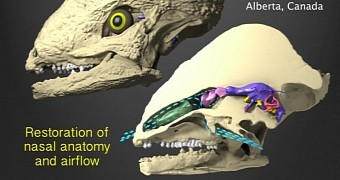Having studied the fossilized remains of several dinosaurs, paleontologists found that these ancient creatures used their nose for more than just breathing. Thus, it appears that a dinosaur's nose also served to cool their brain.
Besides, in a paper published in yesterday's issue of the journal The Anatomical Record, Ohio University researcher Jason Bourke and colleagues argue that, according to evidence at hand, dinosaurs evolved to have complex snouts looking to enhance their sense of smell.
Studying the dinosaurs' living relatives
While working on this research project, study lead author Jason Bourke and fellow researchers started by studying ostriches and alligators, which they say are modern-day relatives of the dinosaurs that roamed the Earth millennia ago.
As detailed by Science Daily, what they did was use computers and all sorts of machinery to gain a better understanding of these animals' breathing patterns. Specifically, they modeled the air moving through their noses.
This technique is actually a branch of engineering, and its official name is computational fluid dynamics. Interestingly enough, this technique is most often employed by scientists in the field of aerospace industry and medicine.
A better understanding of the dinosaurs' anatomy
Having figured out how to use the high-tech gear to study airflow inside a nose, they turned their attention to dinosaurs. The ancient creatures that they chose to work with all belonged to a group of dinosaurs known as pachycephalosaurs.
Writing in The Anatomical Record, the scientists explain that these ancient beasts were plant eaters. Unlike other dinosaurs they shared their world with, they sported a 7-inch-thick (17.8-centimeter) bone on top of their skulls.
Whether this bone served purely as an adornment of sorts or whether the dinosaurs relied on it in combat remains a mystery. What is clear is that the thickness and weight of the bone compelled soft tissue inside their noses to solidity, causing bony nasal turbinates to form.
For those unaware, nasal turbinates are seashell-like structures that protrude into the breathing passage and that help direct the flow. It is now believed that these dinosaurs had not just bony turbinates, but also cartilaginous ones.
The bony turbinates were located towards the back of the nose. The cartilaginous ones, on the other hand, sat closer to the entrance to the animal's nostrils.
Together, these structures worked to direct the air that the animals breathed in towards their olfactory chamber. The structures also served to cool the dinosaurs' brain, thus helping them stay alert and focused at all times.
“Hot arterial blood from the body was cooled as it passed over the respiratory turbinates, and then that cooled venous blood returned to the brain. It may not have been much of a brain, but you don't want it cooked!” Ohio University specialist Ruger Porter said in a statement.
What's next on the agenda?
Now that they have a better idea of what the noses of pachycephalosaurs looked like and what purposes they served, the scientists behind this research project plan to turn their attention to other species and try to figure out whether they too used their noses as a brain-cooling tool.
It is understood that, during future investigations, the researchers will focus on species belonging to two dinosaur groups known to the scientific community as armored ankylosaurs and duckbilled hadrosaurs.

 14 DAY TRIAL //
14 DAY TRIAL //